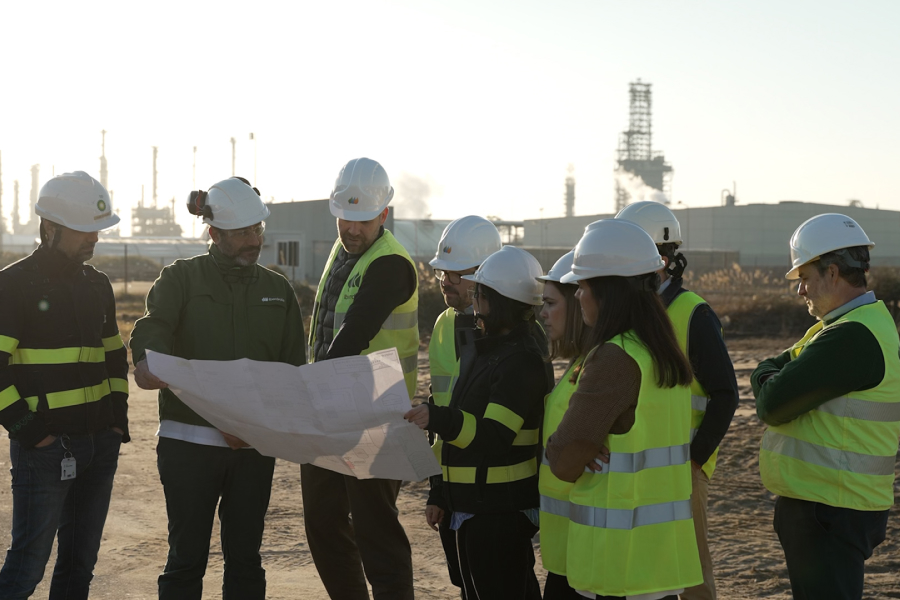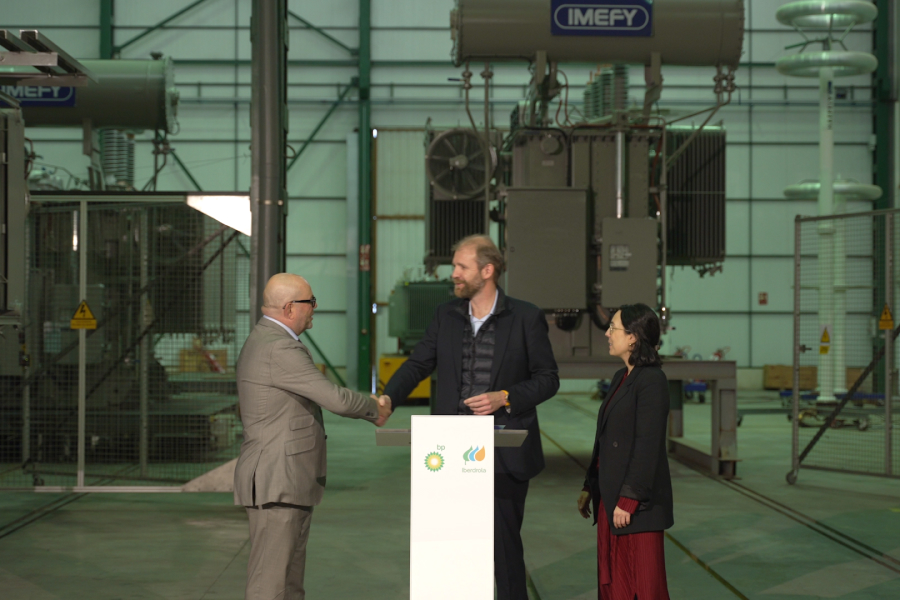Green Hydrogen in Spain
Green hydrogen: an innovative, sustainable and abundant energy alternative to meet the challenges of decarbonising the economy
In the race to decarbonise the energy sector and preserve the environment, green hydrogen is emerging as a key energy alternative.
What is?
In 2022, the demand of the electricity system in Spain reached a total of approximately 250,421 GWh and is expected to increase by 25-30% until 2040. Global energy demand is expected to increase by 25-30% by 2040.
Against this, the European objective of achieving climate neutrality by 2050 is accompanied by an urgent challenge:
It is a technology based on the generation of hydrogen through a chemical process known as electrolysis. In this process, electricity from renewable energy, such as photovoltaic or wind power, is used to separate the hydrogen from the oxygen in the water.
Green hydrogen has the potential to play a key role in the transition to a more sustainable future.
By using electricity from renewable energy, the process is emission-free, which helps to significantly reduce our environmental footprint.
By obtaining green hydrogen through renewable energy, we save, according to the International Energy Agency (IEA), the 830 million tonnes of CO2 per year that are generated by producing this gas using fossil fuels.
How is green hydrogen produced?
1. The water used for electrolysis must contain salts and minerals to conduct electricity.
2. Two electrodes immersed in water and connected to a power supply apply a direct current.
3. Dissociation of hydrogen and oxygen occurs when the electrodes attract oppositely charged ions to themselves.
4. During electrolysis, an oxidation-reduction reaction takes place under the effect of electricity.
Cathodic reaction 4H 4er → 2H2
Anodic reaction 2H2O → O2+ 4H*+ 4e-
Classification of hydrogen
Hydrogen can be classified into different types according to the origin of the energy it uses or the feedstock from which the molecule is dissociated, as well as the associated CO2 emissions. The following main types stand out:
Grey
Hydrogen produced from the reforming of natural gas or other light hydrocarbons such as methane or liquefied petroleum gases by means of reforming processes. At present, 99% of the hydrogen consumed in Spain is of this type and produces 11 kg of CO2 for every 1 kg of grey hydrogen produced.
Blue
Hydrogen obtained in a similar way to grey hydrogen, but with the application of CO2 capture, use and storage (CCUS) techniques , capturing 90% of the CO2 emissions generated during the process . It is not considered 100% renewable, as the future impact of CO2 storage is unknown.
Biogás
Hydrogen from biogas reforming or biochemical conversion of biomass shall also be renewable provided that the sustainability requirements are met.
Black
There are also other types of hydrogen with very different environmental impacts, such as black hydrogen, whose feedstock is coal, pink hydrogen, obtained through nuclear energy, or golden hydrogen, obtained through grid electricity with no guarantee of renewable origin.
Green
Hydrogen generated from renewable electricity, using water as a feedstock, through a process of electrolysis.
Mitigating climate change through green hydrogen
-
Hydrogen is the most abundant chemical element in the universe.
-
Hydrogen is not a primary energy source, but an energy vector: it requires an energy input to be obtained.
-
It is the most efficient solution for the decarbonisation of those sectors that are difficult to electrify, such as the fertiliser and ammonia industry; the metallurgical or ceramics industry belonging to the heat-intensive sector or heavy transport, such as lorries or intercity buses.
Spain as world leader in green hydrogen
Spain has the opportunity to position itself as a technological benchmark in the production and use of green hydrogen. To this end, the Ministry for Ecological Transition and the Demographic Challenge has developed a roadmap that establishes a series of objectives that the country must meet by 2030.
Vision 2030
Specifically, the so-called Vision 2030 envisages an installed electrolyser capacity of 4 GW and a series of milestones in the industrial sector, mobility and the electricity sector for which investments estimated at €8.9 billion will need to be mobilised during the period 2020-2030. This roadmap is updated every three years, which is key to assessing the country's progress in this area.
Ultimately, it aims to make green hydrogen part of the solution to achieve climate neutrality by 2050
Our wealth of natural resources, such as the sun, makes us an ideal country for the production and export of this type of energy, especially to northern Europe.
With the help of this roadmap, Spain could become a world leader in green hydrogen production Several factors play in our favour. To be green, hydrogen needs renewable energies, and we are one of the countries that has made the greatest commitment to them. Our wealth of natural resources, such as the sun, makes us an ideal country for the production and export of this type of energy, especially to northern Europe.
Spain could become a world leader in green hydrogen production.
In short, we have a favourable context to become world leaders in the production of green hydrogen.
Furthermore, we have institutions that are committed to this technology, as demonstrated by the aforementioned roadmap of the Ministry for Ecological Transition and the Demographic Challenge, as well as the umbrella of the European Union, which is also very clear in its commitment to technologies such as this, that facilitate the transition towards a more sustainable use of energy.
We also have a mature market: By the end of 2022, Spain will attract one in five hydrogen projects worldwide.
First company with AENOR renewable hydrogen certification
Iberdrola España has achieved further recognition of its commitment to the use of renewable energies and care for the environment: we are the first company to obtain AENOR's Renewable Hydrogen certificate for the Barcelona and Puertollano projects.
The audit carried out by AENOR confirms that Iberdrola produces hydrogen from renewable energy, with an emission-free production value chain. Thus, the AENOR seal accredits that the company complies with the established European regulation - that the electricity used for the electrolysis of water comes only from renewable energies - in all its processes, from generation to storage and marketing of green hydrogen.
Green hydrogen projects in Spain
The Iberdrola Group, of which Iberdrola España forms part, is leading the development of green hydrogen with more than 60 projects underway in eight countries, including Spain. A pioneer in the use of renewable energies two decades ago, the company has also become a 'first mover' in this new technology and plans to produce 350,000 tonnes of green hydrogen per year by 2030.
Puertollano
At Iberdrola España we have installed the largest green hydrogen plant for industrial use in Europe with a 20 MW electrolyser capacity, located in Puertollano (Ciudad Real).
Barcelona
Green hydrogen is also key to decarbonising heavy mobility. Iberdrola has the first hydrogen plant for public use in Spain, which it has installed in Barcelona's Zona Franca.
Palos de la frontera
Iberdrola España wants to install the largest green hydrogen hub in the country in Palos de la Frontera (Huelva). This project has been selected as an Important Project of European Interest.
Castellón
Iberdrola España and bp join forces to lead the future of renewable hydrogen in the Valencian Community. This is a 25MW green hydrogen project in Castellón, the largest in Spain.
Puertollano
The green hydrogen plant has a dedicated 100 MW photovoltaic plant, with a lithium-ion battery system with a storage capacity of 20 MWh. Through this plant, the renewable electricity required for the production of green hydrogen is obtained. The plant supplies green hydrogen to our client Fertiberia for the decarbonisation of the fertiliser sector by replacing grey hydrogen from natural gas with green hydrogen for the production of fertilisers and green ammonia.
The Puertollano plant involved an investment of €150 million, has created up to 1,000 jobs and prevents the emission of up to 48,000 tonnes of CO2 into the atmosphere.
Barcelona
Iberdrola has the first hydrogen plant for public use in Spain, which it has installed in Barcelona's Zona Franca, where it is already recharging 8 Transports Metropolitans de Barcelona (TMB) buses by producing green hydrogen in a 2.5 MW electrolyser. A total of 60 public buses in the city are expected to use this technology by 2025 or 2026.
Located near the port and the airport, the priority of this hydropower plant is to decarbonise heavy transport. It was commissioned in January 2022 and will be operated for ten years.
Palos de la frontera
This project has been selected as an Important Project of European Interest within the 'IPCEI Hy2Use' initiative, a mechanism approved in 2022 by the European Commission that reserves €5.2 billion for the development of 35 projects in the different member states.
In the first phase of the project, a 200 MW electrolyser with a production capacity of 23,000 tonne H2 green/year will be installed with an investment of €450 million and will create more than 1,000 jobs. During the second phase, a 370 MW electrolyser with a production capacity of 39,100 tonnes green H2 /year will be installed, requiring an investment of more than €500 million. Iberdrola España has close to 1,000 green megawatts under development in Andalusia to ensure a renewable energy supply for a large-scale project such as this.
Castellón
Iberdrola España and bp have created a joint venture to develop a green hydrogen project at bp's refinery in Castellón. This 25 MW project is expected to be operational in the second half of 2026. The 25 MW electrolyser will use renewable electricity through a power purchase agreement (PPA), which will provide 200GWh of power per year from Iberdrola Spain's photovoltaic and wind projects.
This plant will produce an estimated 2,800 tonnes of green hydrogen per year, replacing the grey hydrogen the refinery currently uses, which is produced with natural gas. During construction, the project is expected to create up to 500 new direct jobs. This will prevent the emission of 23,000 tonnes of CO2 per year.
The project has received 15 million euros in funding from the Spanish Recovery, Transformation and Resilience Plan, with funds allocated by NextGenerationEU.
“We continue to work with committed partners to position Spain as a technological benchmark, driving the creation of a green hydrogen industry in Europe,” said Mario Ruiz-Tagle, CEO of Iberdrola Spain.



